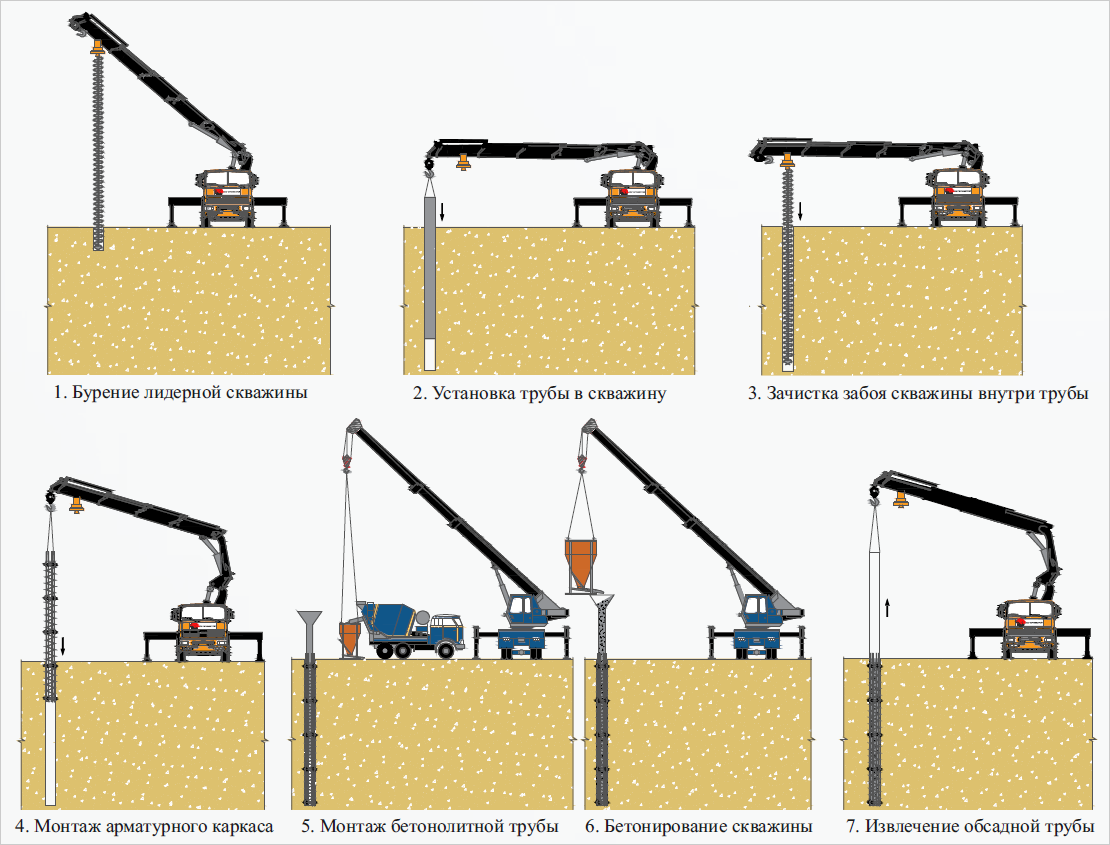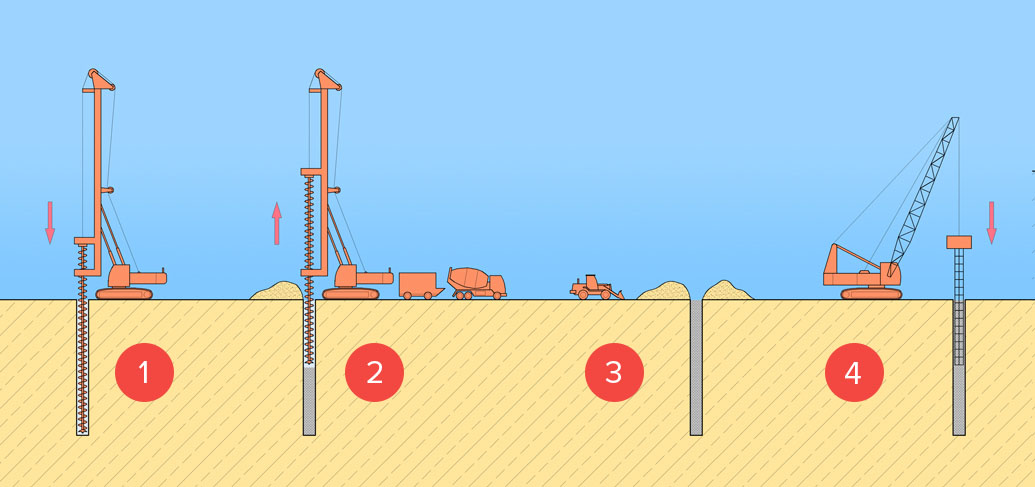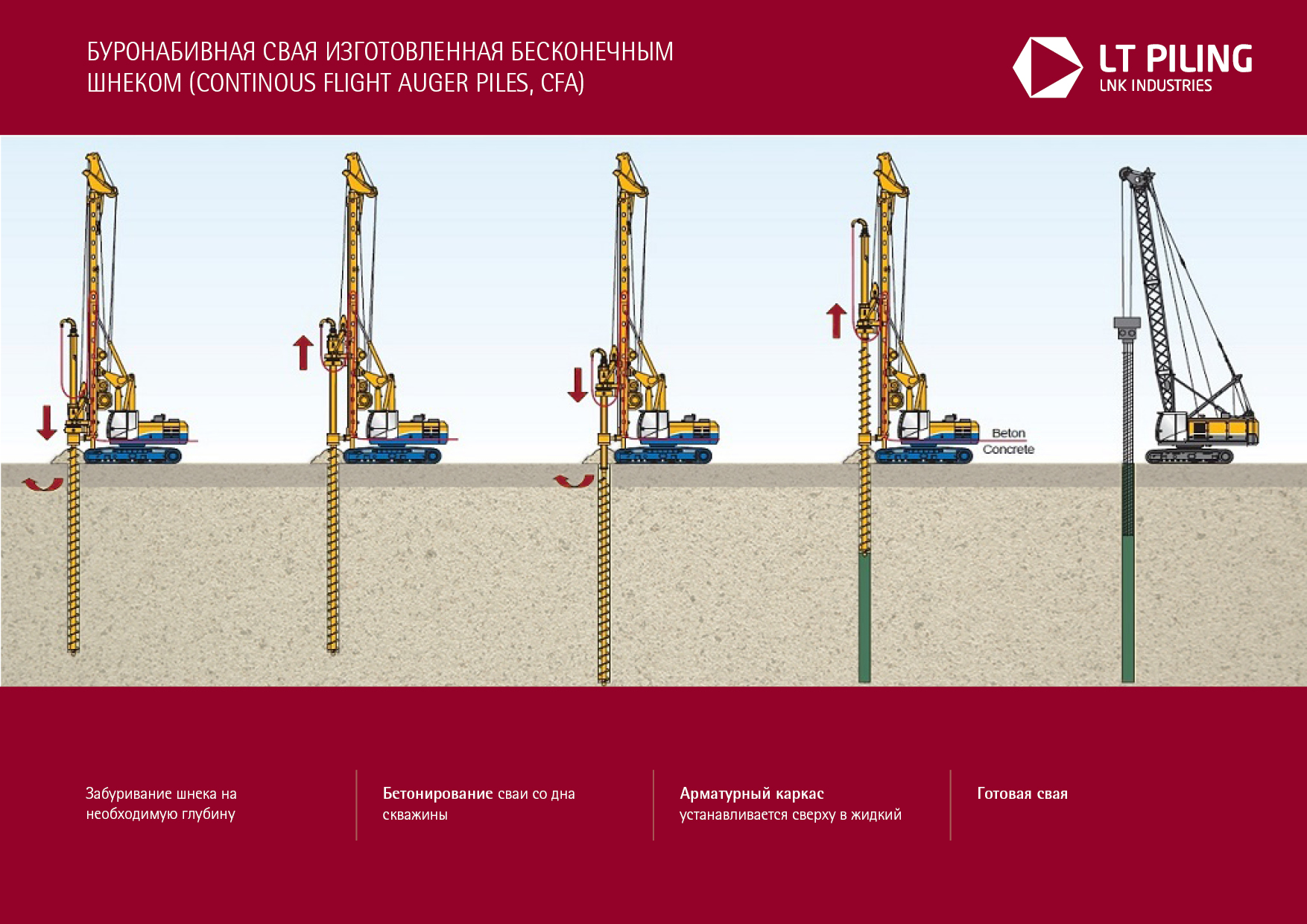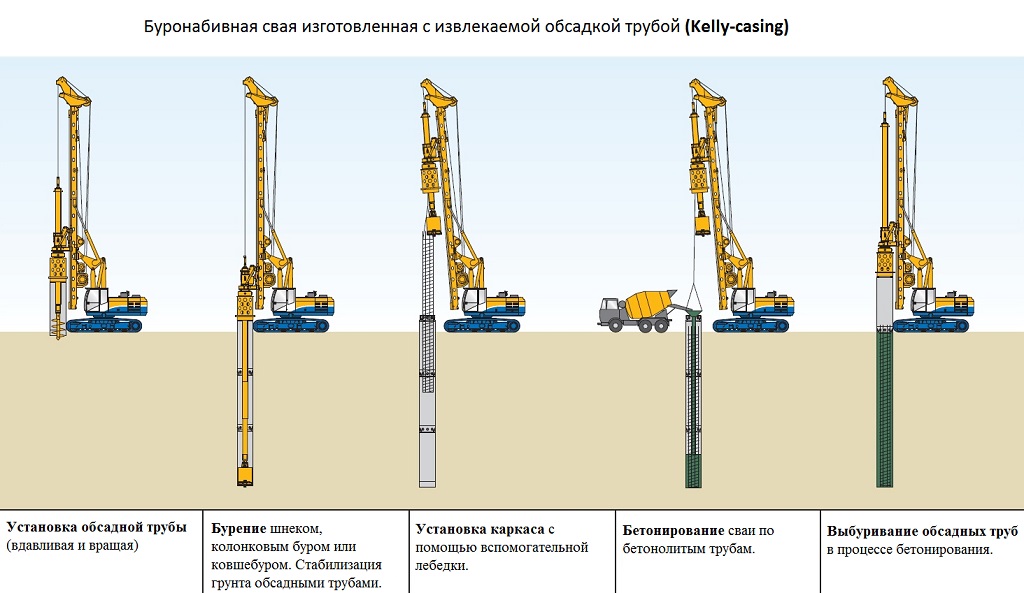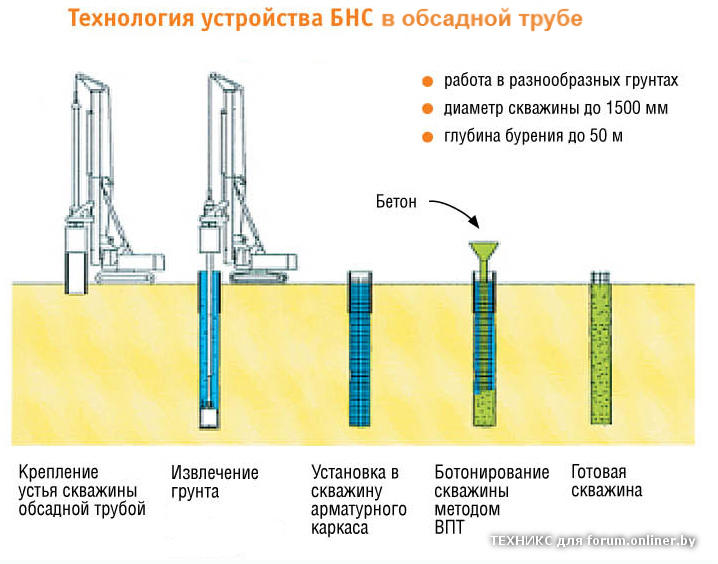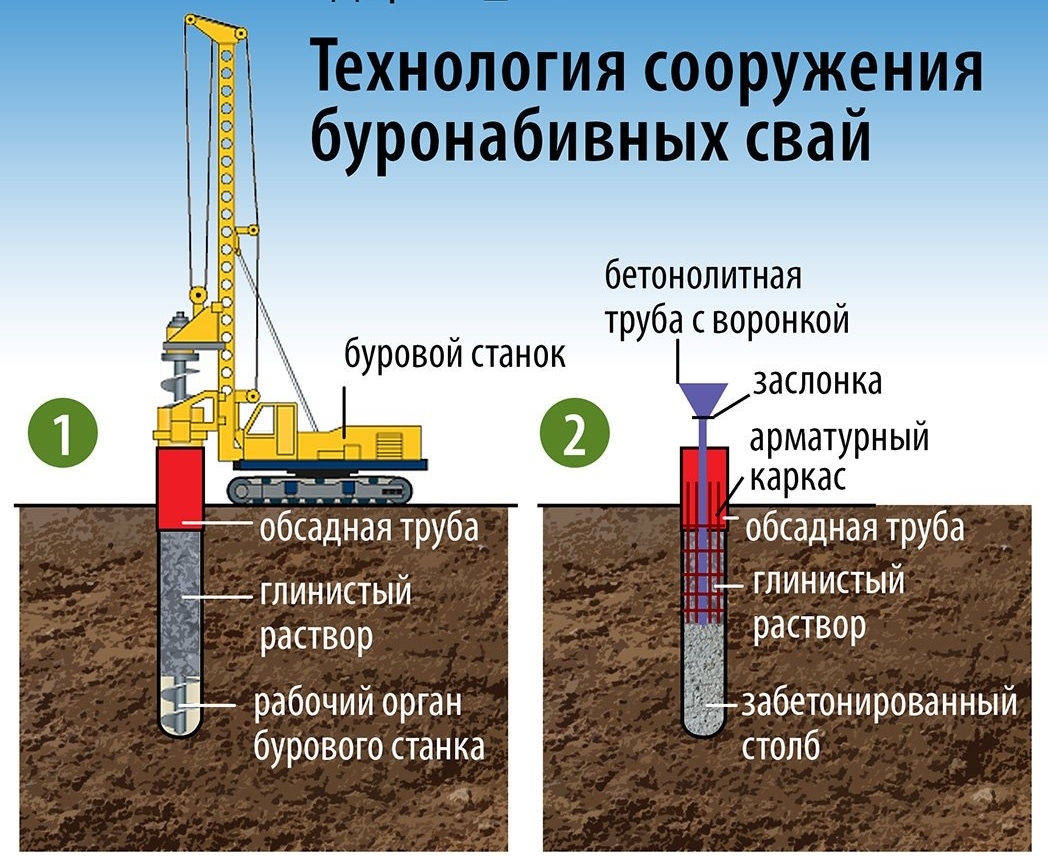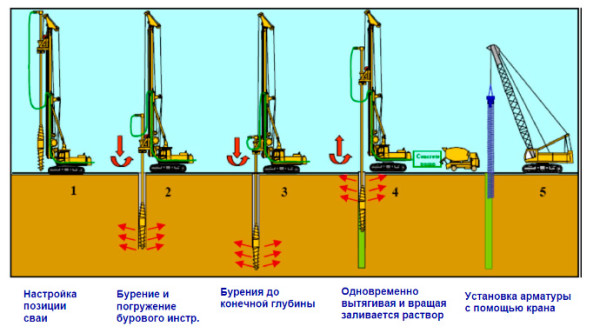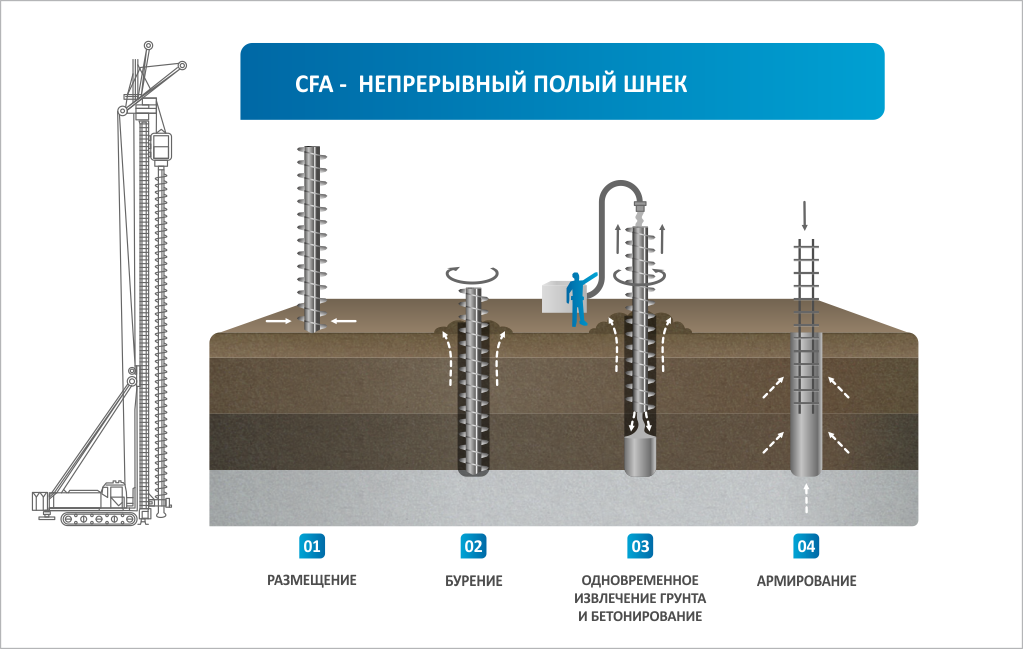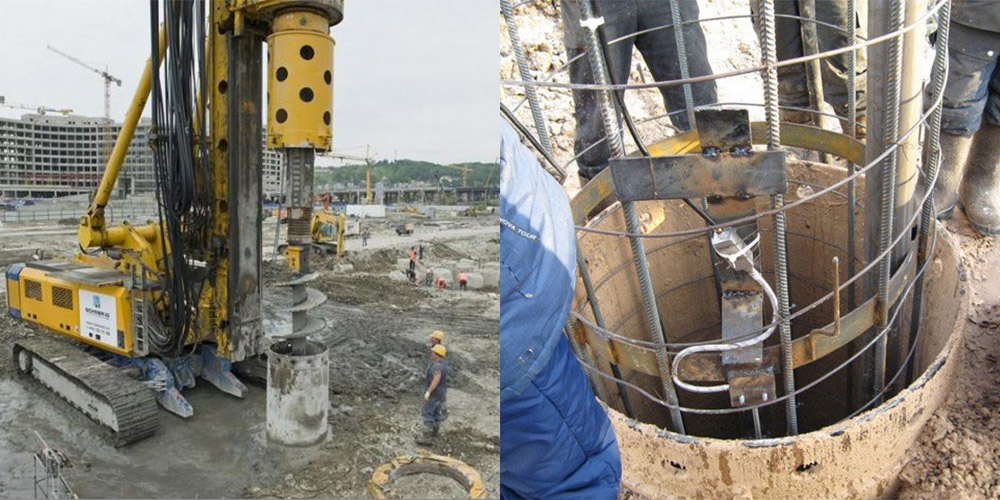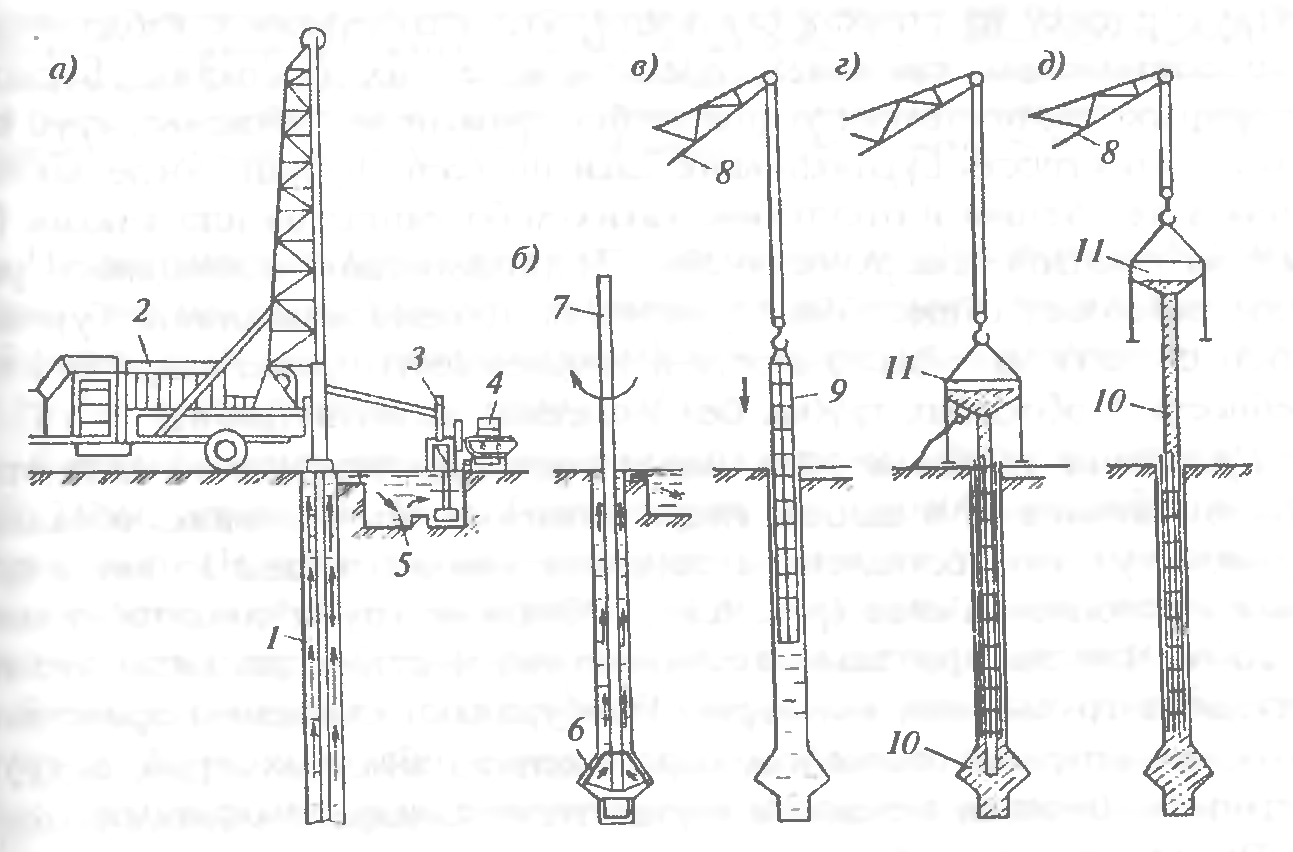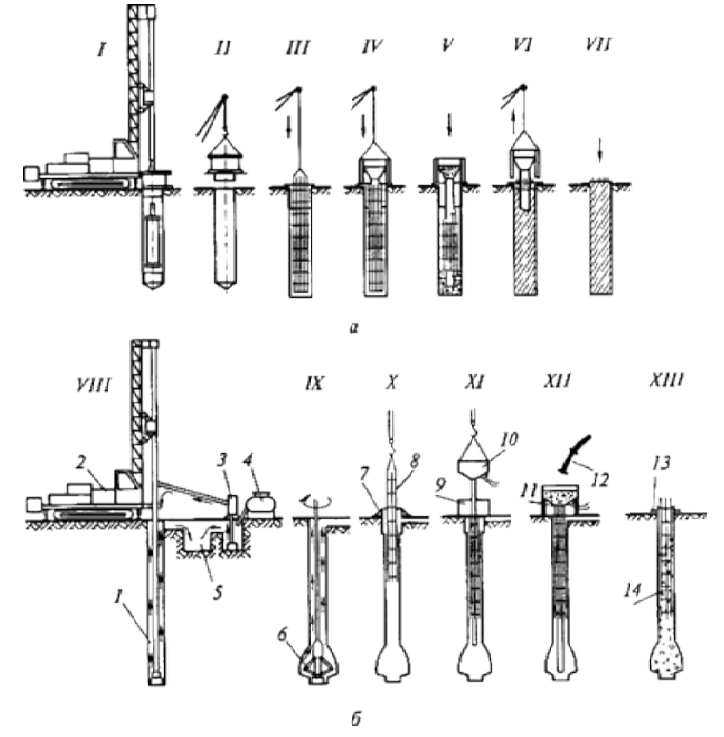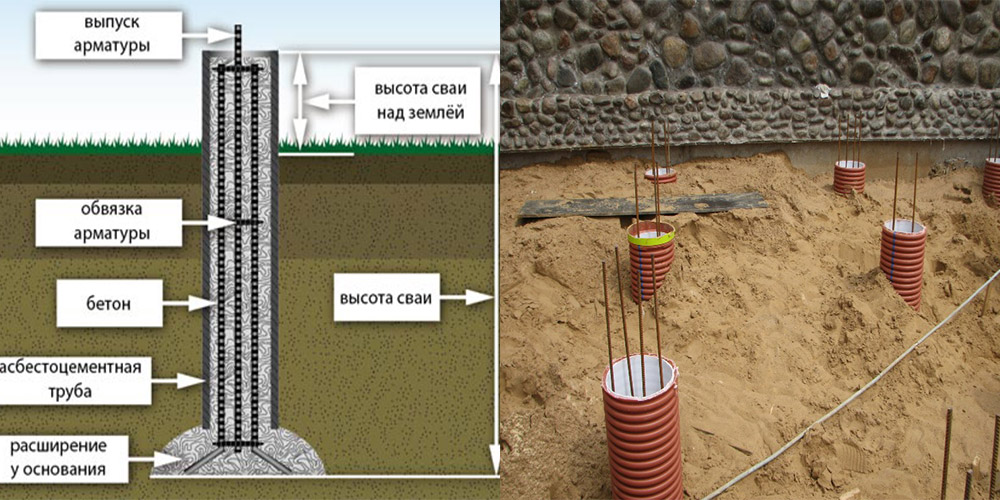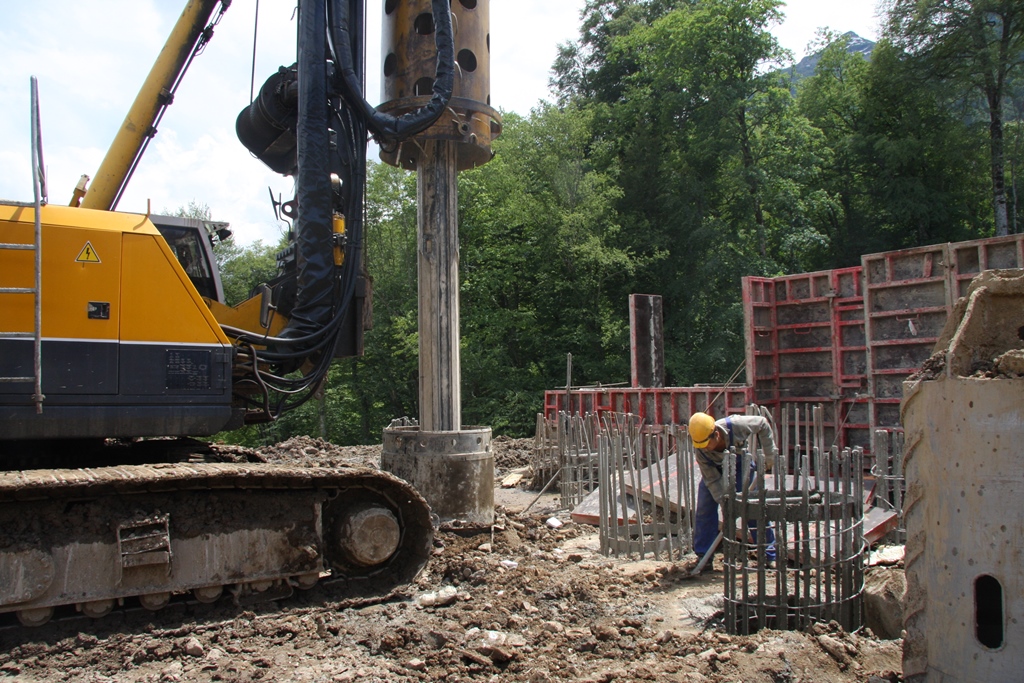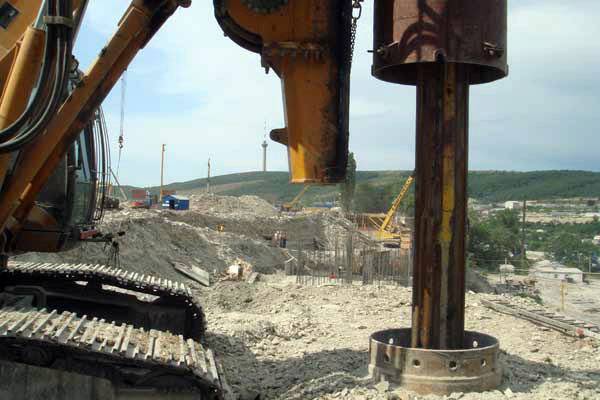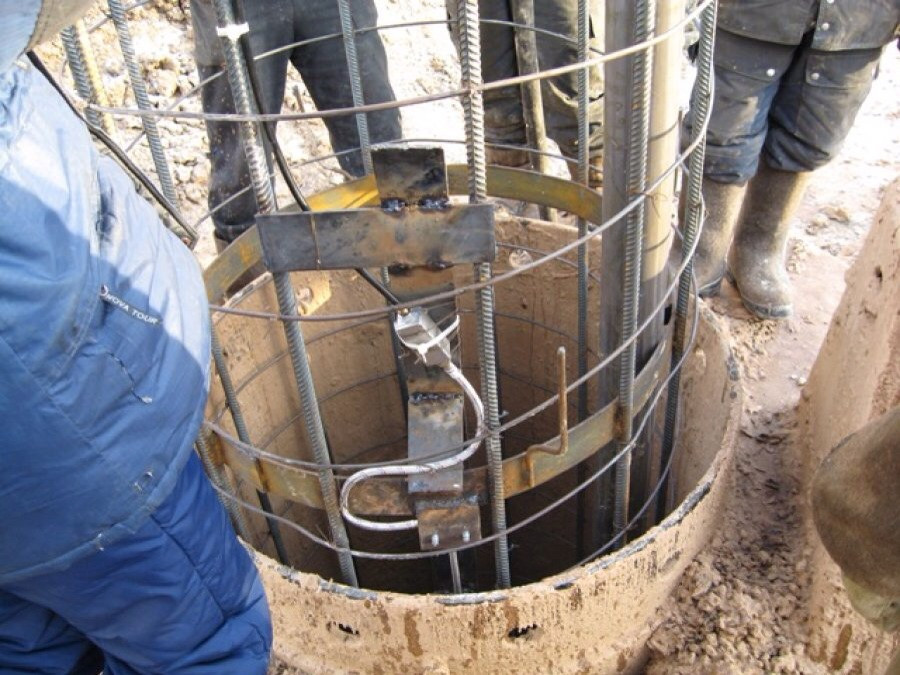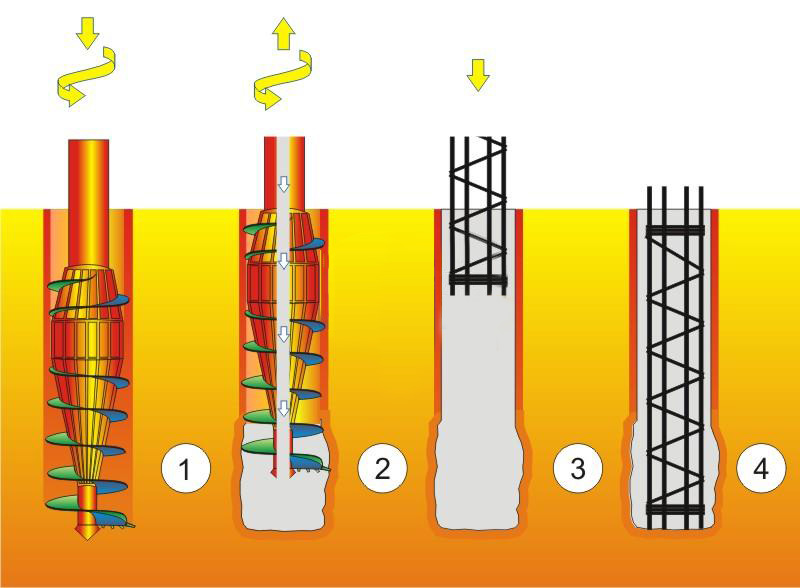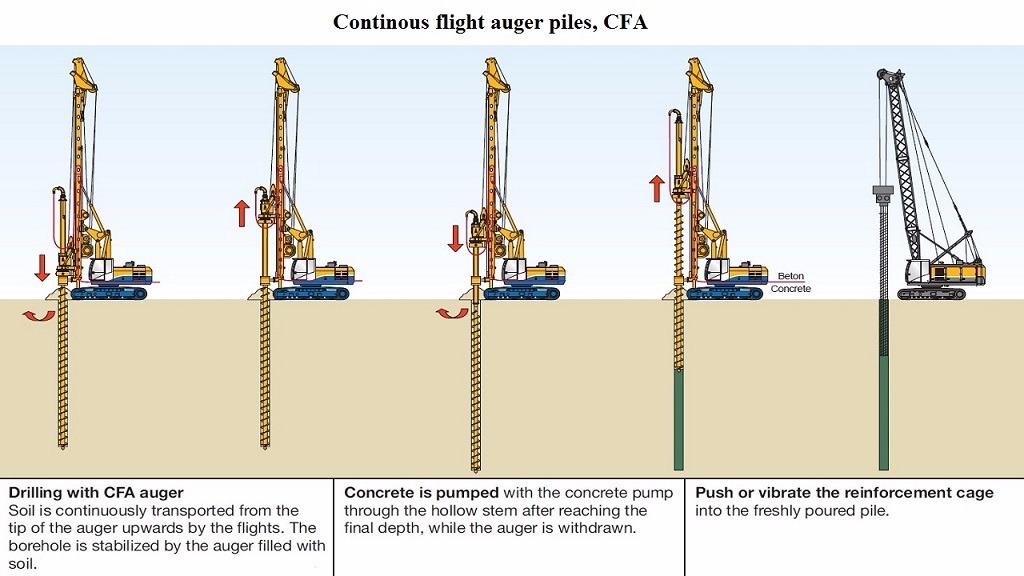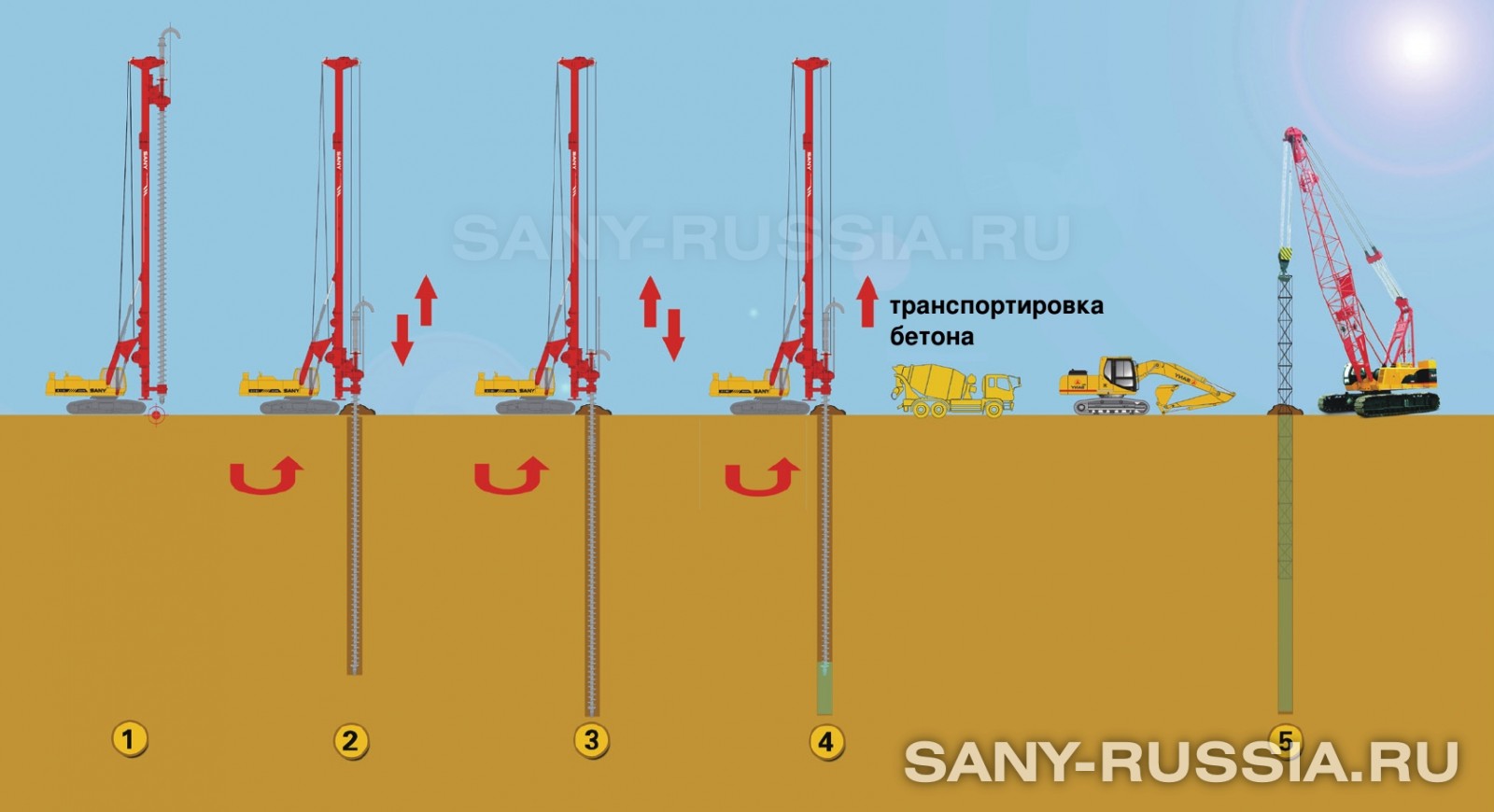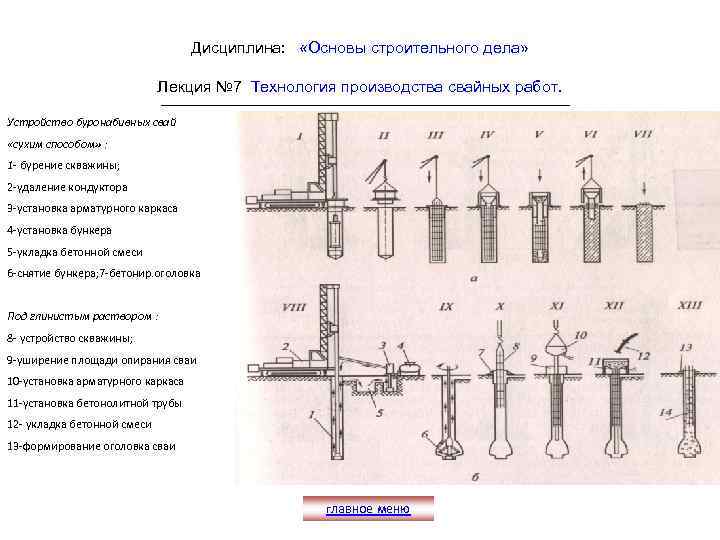Calculation of the pile foundation
When designing a pile foundation, it must be calculated for the expected loads. To do this, it is necessary to know the weight of the entire building, the soil composition of the base and its bearing capacity to a depth of at least 4 meters. If the base consists of soft soil, then it is advisable to go through it to a more durable soil layer. If the piles do not reach a strong layer, they are called hanging piles, if they reach it, they are called piles. According to the accepted diameter of the pile, and its length, its bearing capacity in the given soil is determined.

When designing a pile foundation, a calculation for the expected loads is mandatory.
Further, knowing the total soil load and bearing capacity of one pile, you can find the number of piles for a given house. The piles are installed under the load-bearing walls with a step of at least 2 m. On top of the piles, a reinforced concrete grillage is arranged, which can be either shallow or completely raised above the ground.
Regulatory requirements
At the moment, there is no separate GOST standard for the installation of bored piles, but there is a separate list of rules and regulations that a technician must adhere to when installing any type of pile-type foundation. These are SNiP 02.03, 02.01 and 03.01. Each of these rules was introduced into production at the end of the 20th century, however, their general provisions, due to minor changes in the processes of installing piles, have not changed to the present day.
If you adhere to the requirements of SNiPs, before the installation of bored piles, it is necessary to make calculations of a geological, hydrometeorological and geodetic nature. After carrying out accurate calculations, it is worth choosing: the appropriate type of bored piles specifically for your territory, the size of the piles or supports themselves. You can calculate some of the geological and hydrometeorological data yourself, with the help of an expert technician, or contact the nearest hydrometeorological centers for factual information.
The SP standards assume the influence of climatic factors on the installation process itself. Here the technician is advised:
- to carry out the placement of bored piles in moist soils under thermal conditions of the external environment not lower than -10 Hz;
- carry out the whole range of measures to prevent freezing of the concrete composition before the process of pouring into the well;
- to ensure the proper operation of equipment in certain environmental conditions.
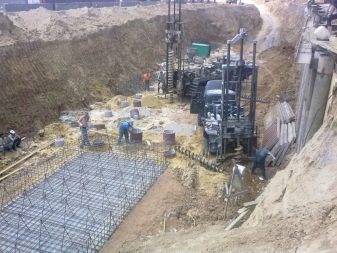
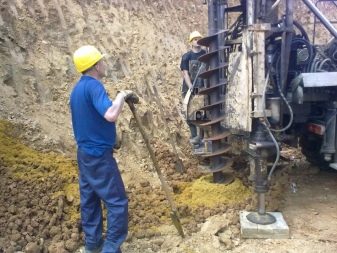
To a greater extent, these requirements relate, of course, to environmental conditions at low temperature values, since most problems arise due to the processes of heaving of the soil (to minimize these processes, you should use data on soil freezing in your territory). At high temperatures, as a rule, there are no problems with the performance of the equipment and the pouring of the solution.


In addition to the described recommendations, a certain set of measures should be taken to prepare the territory for the installation of bored piles.
This complex assumes:
- installation of barriers and warning signs at the boundaries of the work;
- liberation of the territory from all elements restricting movement or construction - they will slow down both the construction process and have an unnecessary effect and load on the ground (if the objects are oversized);
- removal of grass cover and all kinds of shrubs from the construction site - individual plant elements can interfere with the work;
- providing the site with drainage structures - this is both useful for the future operation of an already built house, and it will be useful in the development process itself due to not always favorable weather conditions or too high groundwater levels;
- organize the construction area in such a way that all the equipment necessary for drilling and pouring can freely enter the object and move around it.

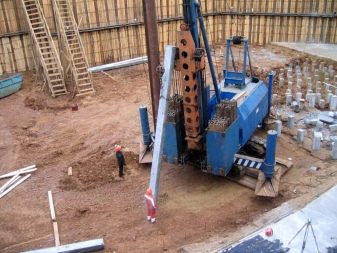

Views
By design, the equipment is of the following types:
- Cylindrical.They are made in the form of a cylinder, inside which there is a longitudinal section, the same along the entire length of the structure.
- With support sole. The lower part of such piles has a large diameter.
By size, there are:
- short;
- long.
By material of manufacture:
- wooden;
- concrete, reinforced concrete;
- soil concrete;
- combined.
Installation technology:
- Driving. These are reinforced concrete or wooden posts, which are a square rod with a pointed end. They are immersed in the ground in a shock manner.
- Screw. These are hollow metal pipes, at the end of which there is a tip that acts as a drill.
- Rammed (pneumatic rammed, screw rammed, frequency rammed, bored). These are supports, for the installation of which it is necessary to drill a well.
- Impressed. These are metal structures that are immersed in the soil under pressure or high load.
By manufacturing method:
- Manufactured by installing inventory pipes. They have a pointed plug at the end, which is left in the well, and the pipes are slowly pulled out as their space is filled with concrete.
- Manufactured using the vibration stamping method is the effect on the concrete mixture of vibration and pressure that the stamp exerts. The wells are filled with concrete and compacted with a vibratory stamp.
- Made by stamping. Pyramidal or tapered boreholes are punched directly into the soil and filled with concrete.
- Drilling machines with camouflage heel. A concrete mixture is poured into a well with a camouflage expansion and a reinforced concrete pile is immersed.
- Injection. A solution consisting of cement and small stones no more than 5 mm wide is poured into a shallow well with a small diameter.
- Buroinjection. An auger is lowered into the well, inside of which there is a cavity. A concrete solution is fed through it under pressure, then it is gradually pulled out.
- RIT type injection piles. The well is filled with cement-sand mortar and treated with a series of electrical discharges. As a result, the pile shaft is formed. This procedure increases the density of the soil.
- Piles-pillars. A cylindrical pile is placed in the well and poured with sand-cement or soil mortar.
According to the method of the device, the piles are divided into the following types:
- Solid piles. They are installed in wells that are located above the groundwater level, without treating the walls with clay solution. If a well is dug under this level, then its walls must be processed.
- Hollow piles with circular cross-section. They are installed using a vibration core.
- Compacted face piles. A reinforcement cage and an injection pipe with a waterproof bag at the end are placed in the finished well. Through it, cement mortar is fed under the pile, then the well is concreted. After the concrete hardens, cement mortar is fed into the waterproof bag, which expands the bag to the required volume, thereby ensuring the compaction of the soil under the pile.
- With the fifth, which is obtained by exploding a charge at the bottom of the well and filled with falling concrete mortar.
The advantage of the technology using bored piles
Casing pipe is a reliable way to strengthen the soil wall in the holes being formed. Pipes for bored piles are composed of rigidly connected sections. The use of this technology in practice is effective not only on problem soils, but also when building buildings in megalopolises on a small area. The speed of development and the cost of installation depends on the main factors:
- general condition of the drilling equipment;
- borehole diameter and depth;
- type of soil.
The principle of the technology of the device of bored piles with a casing pipe is quite simple. During the formation of deep rods, a borehole is formed step by step with the pipes adhering one after another.It is important to firmly fix the casing (of any material) as you move deeper.
- Drilling equipment is installed on the prepared place, which makes the wells of the design width and depth.
- Plastic or metal casing for bored piles is buried by means of a screw-in pipe of the barrel. The required level is fixed in advance in the project documentation.
- Fragments of pipes are interconnected in the way that is provided for products made of this or that material, the so-called "advanced penetration".
- When the drillstring is fully formed, the soil that crumbled during the formation of the hole is removed.
- A frame made of reinforcement under the piles is inserted into the prepared shaft.
- The prepared cement-sand mixture is fed in portions - through a concrete pipe (pile packing).
- The casing is removed from the well section by section.
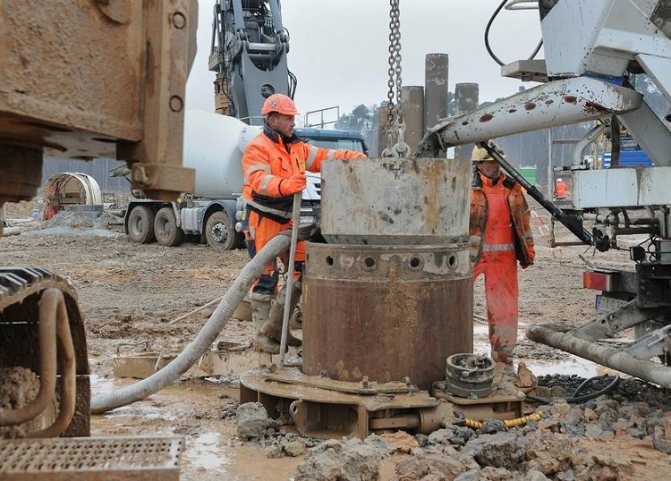
A cement-sand mixture is poured into the prepared well in small portions
Advantages of a safe technology for inserting bored piles with casing:
- the ability to work near closely located structures, due to the absence of shock and vibration processes during excavation;
- work in difficult soils (floaters, water-saturated, weak and crumbling, saline);
- guarantee of a perfect vertical and one hundred percent drilling quality;
- high productivity of drilling equipment,
- the possibility of deep work with overlapping horizons;
- piling safety;
- 100% protection of borehole mines from collapse and control of all stages of the process;
- protection of the drill shaft from groundwater;
- saving concrete with efficient pouring (without necks);
- minimization of the number of miscalculations during installation;
- drilling, broadening, extraction of boulders and coarse fractions when working with a drill;
- control of conformity of design parameters to practical work;
- the maximum possible load-bearing functionality of the well due to the high-quality wall.
Plastic products are one of the types of casing pipes. Polymer parts are produced for different purposes from the following types of materials:
- LDPE - high pressure polyethylene;
- HDPE - low pressure polyethylene;
- PNP - low density polyethylene;
- PVC - polyvinyl chloride.
The casing wall thickness varies within 40mm. These products have many advantages:
- sufficient tightness of the connection;
- lack of corrosive processes;
- low cost relative to metal products;
- low weight;
- high resistance to chemical or other aggressive media;
- faster installation due to the simple connection of the casing sections.
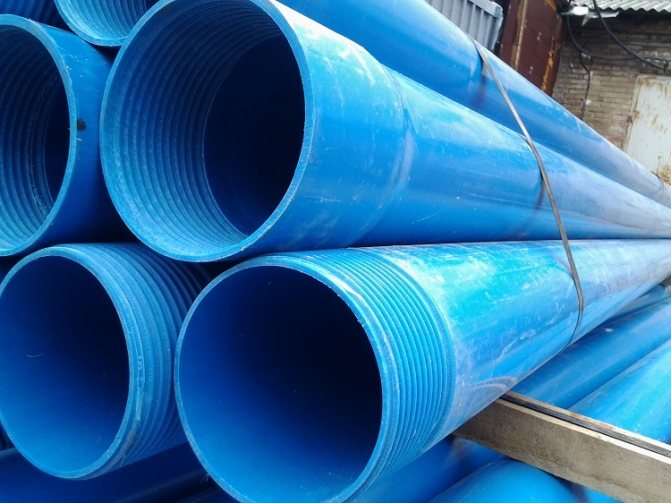
Polymer casing pipes can only be used for domestic water wells
The only drawback is that plastic casing pipes are not very durable, which is why it is easy to destroy their integrity with a sharp blow with a sharp tool and they are not suitable as casing with BNS. These products are preferred to use because of their low cost and practicality for drilling household wells for water supply to private households.
Methods for drilling wells for piles
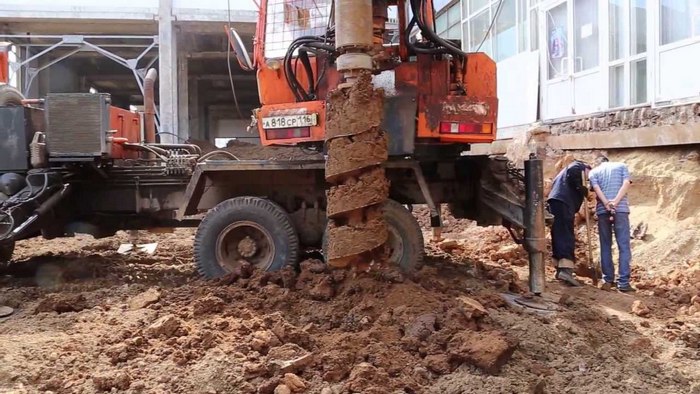 To carry out the ramming method of installing piles, professionals use two methods of drilling rotary and percussion wells.
To carry out the ramming method of installing piles, professionals use two methods of drilling rotary and percussion wells.
To carry out the ramming method of installing piles, professionals use two methods of drilling wells:
- Rotational;
- Shock.
The first method is used in industrial construction and in private construction on elastic or solid soils. Here, a drilling rig or a simple auger (in the case of doing the work with your own hands) develops the soil with rotational movements, lifting it up along the blades of the drill. Well development technology in this case is performed much faster in time.
The percussion method of well development is used on soft sandy soils.Here, a winch and a glass made of a pipe segment with a sharp lower edge are used as equipment. When such a glass rises and drops sharply into the soil, the sharp lower edge of the pipe cuts into the ground, grabbing it. Then the glass is hammered in an impact method even deeper. When the pipe cavity is completely or almost completely filled with earth, the glass is raised to the surface and freed from the soil. Then the actions continue until the desired well depth is reached.
Benefits of using rammed piles
This type of arrangement of the foundations of buildings has not yet become widespread, due to the specificity of the technology used for its arrangement. However, the development of technology and the machines used makes it possible to significantly increase the national economic importance of bases of this type. Their use has a number of advantages, including:
The possibility of concentrated perception by individual piles of a significant load, reaching 1000 tons, which allows them to be placed under structures that transfer a large mass to the foundation. In most cases, these are buildings used in industry and manufacturing, or multi-storey buildings.
The possibility of individual perception of huge loads by piles makes it possible to lighten the structure of the grillage or to abandon its use in principle. A connecting or transitional link, in the form of a grillage, can be mounted without the use of additional parts and reference to the depth.

The advantage of rammed piles
One of the main positive qualities that characterize this type of piles is the insignificant absolute and relative values of their displacement in the soil during the settlement process.
The significant load carried by the structure of one load-bearing element avoids the use of multiple driven-type parts.
If it is necessary to use rammed piles with small dimensions, their bearing capacity can be increased by broadening the lower surface of the structure. An increase in the supporting surface of the load-bearing elements from 7 to 12 times makes it possible to significantly increase the perceived loads.
This type of structural element can be used to reinforce existing foundation structures.
Technological features
Usually the diameter of bored piles does not go beyond 880-1200 mm. In length, they can reach 35 m. In order for the piles to take shape, they use a cast concrete mixture.
To make different pile designs, four methods are used:
- Continuous auger technology. Inside it is a cavity for supplying concrete to the lowest point of the well.
- With casing. It is immersed and removed using a vibratory pile driver. This protects the walls.
- With bentonite mortar, which does not allow the walls to crumble.
- Casing technology, which is submerged using the rotation method.
Continuous auger technology
This technology is used in solid soils, most often in clayey soils.
The auger has a pipe, to which a special spiral is welded, capable of removing soil. This is how a well is drilled on the ground. The auger rotates, the drilling part crushes the soil, and it is fed to the surface in a spiral.
At the end, the inner cavity is closed with a plug with a check valve function: it does not allow the drilled soil into the cavity.
First, the desired depth is selected, the plug is opened, concrete is gradually fed in and fills the well. When it is full, the auger is removed (by rotating or simply pulled out without rotating).
In order for the concrete to freeze, the well is left with a solution for a while.
For the installation of reinforced concrete piles, a frame made of reinforcement is lowered into the well with a vibrator.

Casing technology
This method is used when the soil is landslide or unstable.The casing pipe is able to protect the well: it does not allow the walls to collapse during drilling, "holds" the soil layers around the well so that they do not press, and does not allow the reinforcement cage to collapse when it is introduced.
The technology process is as follows:
- It is necessary to immerse the pipe in separate parts (you need to remove it in the same way).
- Immersion method: indentation, vibration or rotation. After that, you need to pull out the drill and the rest of the soil, fill the pipe with concrete or a reinforcing cage.
The fittings are placed in the center of the well to obtain a protective layer of 60-70 mm. The next stage is the pouring of the concrete solution and its compaction. The well is filled with concrete and the casing is gradually removed.
When arranging piles-racks, to support them, you need to expand the bottom of the well. The soil must be removed up to 1.5-3 borehole diameters. If the well is camouflage, it can be compacted with an explosion.
Fundex casing technology
This method became popular several years ago thanks to the so-called sparing regime. The work takes place without shock and vibration, so there is no risk of damaging nearby structures. At the same time, the soil retains its physical and mechanical properties.
The diameter of products that are made using this technology is in the range of 450-600 mm. This technology is usually used in areas where the seismic situation is unstable.
The well is drilled with special tapered rollers, which are mounted on a common shaft. They are drilled simultaneously by the method of rotation and indentation, which does not allow the soil to fall to the surface.
- The rolling tip is made of cast iron. It is screwed into the ground and left inside, it becomes a reliable support for the pile.
- The pipe is attached to the rolling-out, it is checked whether there is water in the pipe. If not, you can install a frame made of reinforcement.
- Then the primer is fed. The special solution contains equal amounts of water, cement and sand. Therefore, it does not allow the concrete to delaminate.
- Then the pipe is filled with ductile concrete and pulled out while rotating back and forth.
The pile technology is selected based on the soil. In addition, the overall financial component of the pile foundation is also important.
Usually no casing is left in the well.
According to the law, they can be left on only in extreme cases. Let's say if the soils are landslide on the slopes or the speed of movement of underground streams is more than 200 meters per day. For each exceptional case, a technical justification must be drawn up.
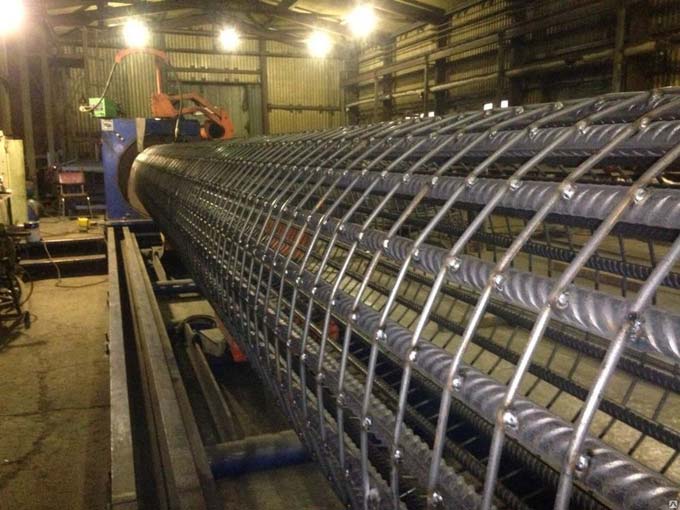
Disadvantages in the arrangement
The use of drilling injection technology also has certain disadvantages. So, during the arrangement of these piles, in contrast to the rammed and bored supports, there is no artificial soil compaction. That is, their carrying capacity is at the level of the natural state.

The use of drilling injection supports is often impossible due to the threat of the concrete composition being squeezed out of the soil by groundwater until it dries up completely. This process can occur during the construction of foundations in sandy watered soils with a high filtration coefficient, as well as active movement of groundwater.
Some doubts about the quality of the foundations already made can also be caused by the technology of their arrangement. Difficulties often arise during the immersion of the reinforcing cage in concrete, which, at low pressure, sinks to a depth of no more than 75-85% of the support length. Subsequent immersion of the reinforcement, which occurs under increased pressure, leads to a violation of the integrity of the reinforcement, its bulging from the walls of the support. That is, the lower section of the pile is almost without reinforcement.
How to create a bored pile structure with your own hands?
After all the wells have been drilled, the developer can start pouring the bored piles with his own hands. This process requires adherence to technologies that provide for the phased implementation of all work.The developer in this matter will be helped by step-by-step instructions, thanks to which they will be able to minimize errors and build reliable and durable supporting structures.
 A do-it-yourself bored foundation is created as follows:
A do-it-yourself bored foundation is created as follows:
- Formwork is being built, the type of which is determined based on what technology will be used for the piles. If the borehole diameter does not exceed 50 cm, then a piece of roofing material can be used, which rolls up in the form of a cylinder and is immersed in the hole. When erecting cottages and light buildings, a polymer pipe can be used for formwork. For more massive structures, an asbestos-cement pipe should be used, which will improve the bearing capacity of the foundation structure. If the wells have a large diameter, then the developer will have to use panel formwork, which is usually used when pouring a columnar foundation.
- Formwork reinforcement. The use of metal frames when creating bored piles allows them to provide maximum strength, reliability and durability. To create a frame, developers will have to use 4 rods (vertical), the diameter of which must exceed 10 mm. A metal ring is installed between the reinforcement in several places, which will fix the diameter of the frame. Strapping is carried out on top of such a structure. The self-made reinforcing cage is installed in the well so that the upper rods protrude from the concrete. This is necessary in order to subsequently perform a bundle of piles with a grillage.
- When pouring bored piles, the technology provides for the use of concrete, the grade of which starts at B22.5. A hopper should be installed at the wellhead to prevent soil collapse, which will create an uneven concrete structure. Through it, the concrete mixture will be fed into the hole, which contains formwork and a reinforced structure. If the developer will use a coarse-grained filler for concrete, then he should use a deep vibrator nozzle during the pouring process. The technology for creating bored piles prohibits the use of brick broken as a filler for concrete mix.
- The creation of the grillage is the final stage in the construction of the bored foundation structure. The developer must build formwork around the entire perimeter of the foundation. The shields are fixed to each other with studs, and reinforcement is laid inside. A grillage for this type of foundation cannot pass engineering communications, so they are carried out under it.
After the completion of the concreting, the formwork is dismantled. Sand is removed from under the grillage, and the resulting voids are protected from accidental filling with soil with sheet material. Self-creation of such a foundation structure will allow the developer to save up to 40% of their budget.
Bored piles - what is it
The technology of bored pile installation includes two processes: drilling wells and filling them with reinforced concrete right at the work site. That is, vibrations that inevitably arise when the finished piles are driven by the shock or vibration method are excluded. Because of these vibrations, blocking in the city is practically not used, and the vibration method is limited.
In terms of safety, screw piles can compete with bored ones. But they are only suitable for low-rise buildings due to their limited bearing capacity. A bored foundation may well take on the load from a multi-storey building, it all depends on the parameters of the piles and grillage. In particular, the immersion depth of a concrete rod can be up to 30 meters or even more.
Other advantages of bored pile technology:
- the possibility of using on soils with debris.In this case, the immersion of finished piles is complicated by natural obstacles and it is practically impossible without drilling leader wells;
- compactness of equipment. Thanks to her, bored piles can be made even underground;
- relative cheapness of the process - cheap consumables and no expensive heavy equipment is required.
The design of piles and the foundation as a whole is carried out on the basis of design parameters:
- immersion depth;
- trunk section;
- the number of piles and the distance between them.
This also includes the presence / absence of broadening. Broadening (heel) is mandatory on clay soils to avoid pushing the pile out during frost heaving. In other cases, it depends on the characteristics of the soil and structure. Our specialist will provide advice on this and other issues for your object free of charge.
The pile parameters are determined based on the expected loads on the foundation. The following loads are taken into account:
- the mass of the structure;
- soil resistance at the foot of the pile;
- soil resistance at the lateral surface of the concrete rod.
The initial data for different soils, the necessary coefficients are in the SNiP tables. Key technical and organizational aspects of the workflow are presented in the technological map for bored piles:
- introductory part - scope;
- justification of the choice of technology, its features for a given object;
- recommendations for the organization of work;
- production cycle schedule for this type of wells;
- calculation of labor costs;
- technical and economic indicators, time spent on equipment operation;
- a list of resources - equipment, tools, materials with an indication of GOST for each position;
- quality control chart indicating the position of the person responsible for controlling each operation.
We have been assembling bored piles for over 10 years
For all questions call: 8 800 707-72-09
We will help you choose the most suitable and economical option for manufacturing a bored foundation.


